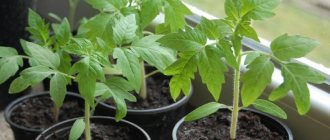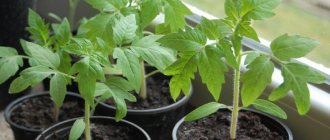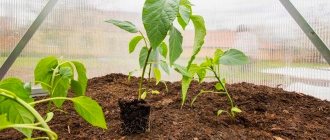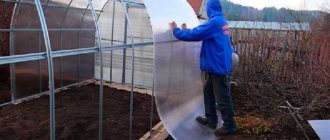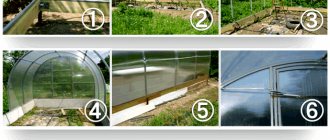Many people are sure that it is necessary to install a greenhouse in the spring, because that is when it is needed. Most of our compatriots do exactly this, postponing the installation of a greenhouse until spring. And then in the spring problems begin, as a queue forms and you have to wait for a very long time. This in turn leads to the seedlings becoming overgrown, since due to possible frosts it is impossible to plant them in the ground. Therefore, some even have to wait for the installation of a greenhouse until June, when there is no longer any need for it.
Cleaning the greenhouse
After harvesting the garden, the area is cleaned: garbage is burned, beds are dug for spring, and dry stems from vegetables are removed.
A small indoor vegetable garden was no exception. After harvesting, it is necessary to carry out certain measures to clean the greenhouse. First, the existing auxiliary devices that were used to tie up the vegetables are removed: slats, ropes, ropes. It is necessary to pull out remnants of vegetation in the form of leaves, weeds, and stems. This will provide protection against infection during subsequent planting. A convenient way would be to collect organic matter and burn it. In some cases, gardeners place these residues in the used compost pit, and as a result receive excellent fertilizer. It is also necessary to disinfect the soil.
In a greenhouse, you need to dig up the soil, and during the process, get rid of existing roots along the way. If leaves get clogged into greenhouse crevices, the joints can be breeding grounds for diseases. Everything in the greenhouse must be carefully checked.
Soil care
When growing different crops in a greenhouse, the soil can be completely depleted over the summer. Therefore, before growing a new batch of plants, it is necessary to enrich the soil with microorganisms and minerals.
This task is perfectly accomplished by adding complex mineral fertilizers and humus to the soil. Humus contains a lot of minerals that are required for plant development. At the same time, many nutritional microorganisms enter the soil. It makes the soil more permeable, breathable and loose.
Therefore, before growing a new batch of plants, it is necessary to enrich the soil with microorganisms and minerals.
There is no need to use a large amount of humus, as the plant roots will dry out quickly. Leaf mass may even begin to grow to the detriment of fruiting.
Turf soil, which contains many rotted roots of trees and herbs, is useful for plants. This composition allows you to increase the saturation of nutrients and moisture absorption.
The turf is harvested by removing the top layer, and then stacked and sprinkled with lime. The laying is 1.5 m high. Humus is poured between the layers of turf. During the maturation process, it is necessary to water the turf with slurry and periodically turn it over.
It is better to harvest turf soil in meadows and fields. You should not use one that is located near swampy areas, the soil there is too acidic.
Sun protection
One of the main problems when growing vegetables in a greenhouse is excessively high temperature, from which all plants suffer on hot summer days. In mid-summer it often rises to 40-45°C, which is extremely undesirable, because already at 30-35°C the setting sharply decreases. It is not possible to lower this temperature by simple ventilation. For this reason, we have to look for other ways to reduce the temperature in the greenhouse in the summer.
One option is to use any white covering material. It is also useful in that it protects plantings not only from heat, but also from condensation, which often leads to the development of fungal diseases. It is better to create such protection before planting, at the stage of preparing the greenhouse for the new season.
You will need agrofibre with a density of 17 to 23 g/sq.m and a dense cord. Stretch a cord along the horizontal slats of the frame inside the greenhouse, as well as along the ceiling. Then thread the covering material through it and stretch the fabric around the circumference of the entire greenhouse. To prevent the cord and fabric from sagging, secure them in several places with plastic clamps (ties). Grab the material, cord and frame at the same time and secure with a clamp. Place these fasteners at a distance of approximately 1 m from each other.
- How to protect plants from heat in a greenhouse
Excessive heat is just as destructive to plants as frost. Are your green pets definitely not suffering in the greenhouse?
Throwing snow into a greenhouse in winter
The most important measure for preserving the nutritional value of the soil is its preservation from deep freezing during severe frosts. Snow cover provides protection from freezing of open ground, and snow does not fall into the greenhouse during winter. To do this, snow is placed in the greenhouse mechanically. When snow melts, it can moisten the soil, which will perfectly prepare it for planting.
Before the process of throwing snow into the greenhouse, autumn disinfection treatment should be carried out so that pests and diseases do not remain under the snow cushion.
You should not throw snowdrifts inside the greenhouse; it will be enough to use a small layer that covers the surface. If a lot of snow is added to the greenhouse, you will have to postpone planting until the soil dries out.
Some gardeners have an ambiguous attitude towards the use of snow in a greenhouse. They believe that this cannot be done due to the fact that snow can delay the time it takes for the soil to warm up in the greenhouse.
It is not recommended to throw snow into a greenhouse if groundwater is located close to the site. This can create an impenetrable swamp in the greenhouse, making it impossible to plant plants there for a long time.
What is a greenhouse for?
In early spring, seedlings of heat-loving crops are grown in a greenhouse. It turns out well developed and strong, takes root better and gets sick less. It is also used for hardening off seedlings grown indoors.
Cold-resistant green crops - dill, parsley, radishes, lettuce - feel great in a greenhouse. At the end of April, early cucumbers can be sown in it.
In the summer in the middle zone, a greenhouse is used for growing low heat-loving crops - melon, watermelon, pepper, eggplant. Portable structures are useful for protecting plants from heavy rains.
In the fall, early-ripening, cold-resistant crops are again grown in the greenhouse or used to force root crops into greenery. Before the onset of frost, you can store vegetables in it, and if the winter is not too cold, then flower bulbs.
Winter care
After inspecting the soil for the presence of insect larvae, they need to be collected. The entire internal surface is cleaned of dirt. Then the greenhouse is fumigated and ventilated. In polycarbonate greenhouses with a metal frame, smoke bombs are not used for fumigation. They destroy the polycarbonate layer and spoil the metal. You can only use “Whist” checkers, which are based on tibentazole.
A five percent formaldehyde solution provides excellent disinfection of walls. It is better to spray it using a spray bottle. After treatment, it is necessary to close the room for a day. The greenhouse is then opened and ventilated. All paths must be washed and treated with special disinfectants.
To prevent the greenhouse frame from bending under the weight of snow in winter, it needs to be strengthened. It is important to carry out this process when the site is located far from the gardener’s place of residence, when it is not possible to clear the greenhouse cover from snow.
Various supports are used in the form of frame reinforcing elements to ensure the distribution of weight pressing on the surface. The number of supports should be such that reinforcements are used every one and a half meters. The supports are fixed there so that they cannot jump out and break through the coating. A stone or brick is placed under the lower part of the supports so that it cannot fall underground.
It is necessary to close all ventilation openings and windows tightly. The foundation is inspected to seal any gaps that have formed. This action cannot be left until the spring; these holes may further deteriorate over the winter.
If snow freezes in a polycarbonate surface during a thaw, you should not scrape it off so as not to damage the surface. The presence of scratches reduces the light-transmitting properties of the coating. The snow needs to be moved along the entire perimeter from the walls so that they do not lose their shape under the weight of the snowdrifts.
The door to the greenhouse must be closed in winter. Under a gust of wind, it shifts, and the polycarbonate sheets can come off. During the season, it is necessary to regularly ventilate the greenhouse, especially during thaws.
If the rules for caring for a greenhouse in winter are followed, this will significantly extend its service life. Taking good care of greenhouse equipment will ensure its reliable use for many years.
Preparation of documents for greenhouse farming
Before registering a greenhouse farm, you need to familiarize yourself with the basic legal forms of running an agribusiness.
- IP (Individual Entrepreneurship) - suitable for large volumes and a wide distribution network, where certificates of conformity are required.
- Peasant farm (peasant farm) - suitable for partner business. With this form of registration, you can qualify for government support services.
- LPH (Personal subsidiary plot) - for registration, the area of land owned or leased must not exceed 2 hectares.
The agricultural tax system is one of the lowest and amounts to 6% of income.
How to care for a greenhouse in autumn
In the summer, when the crops ripen, the greenhouse does not require special care. Occasionally you can water the walls with a hose, washing off the dust. It is also recommended to ventilate it. The main maintenance work on the structure occurs in the fall.
In the fall, summer residents harvest from their gardens, including greenhouses. For the winter, the greenhouse must be removed and completely closed until the next planting season.
Proper care of a greenhouse in the fall includes:
- Cleaning up plants after harvest. All tops, leaves, and weeds should be removed from the ground. Remove all fertilizers and soil cultivation tools.
- Soil treatment. The soil in the greenhouse is treated with special bactericidal preparations or watered with boiling water. It is recommended to remove a layer of 5-7 cm of old soil, replacing it with new one.
- Fertilizing the soil. The quality of the soil under a greenhouse can be improved if you sow it with green manure in the winter - peas, rapeseed, mustard. You can add humus and various mineral fertilizers to the soil.
- Disinfection. The carbonate coating of the greenhouse should be washed with dishwashing detergent. This prevents the proliferation of harmful fungal microorganisms and extends the life of the structure. It is very important to clean all joints and crevices; for this you can use a soft cloth and a spray bottle. As a disinfectant, you should choose only those that are approved for polycarbonate coatings.
- Conservation. After all cleaning work, you need to ventilate and dry the room, then check all latches and locks.
Checkers are used as disinfection, which release sulfur gas when burned. To get rid of the smell, the greenhouse must be left open for several days.
Among the means of disinfection, one can highlight a folk method, which consists of using a decoction of pine branches. Pour boiling water over ½ bucket of needles, let it steep for 30-40 minutes, after which it can be used as a disinfectant. This disinfection method can be used in spring and summer to treat the walls and roof of a greenhouse.
Caring for a greenhouse in winter: basic maintenance rules
If the greenhouse is located on a site outside the city and no one is there in winter, the polycarbonate structure can be removed and hidden in a shed. This is only possible if the greenhouse is removable. Stationary polycarbonate greenhouses cannot be moved; they can only be completely dismantled.
They do not require special care in winter, but you should still pay attention to some maintenance rules.
Important details:
- Monitor the temperature inside the greenhouse. Before the onset of frost, and even better in the summer, install heating elements. For residents of private sectors in the city, you can use heating from electricity, and outside the city you can install a wood-burning stove. In winter, all that remains is to regulate the heating, depending on the outside temperature.
- Monitor the growth of plants under the greenhouse. Periodically water the plants and ventilate the greenhouse.
- Clean the roof from precipitation using special brushes that do not harm polycarbonate.
Icicles and frozen snow should never be scraped off the surface of the greenhouse - this can lead to damage to the coating. To gently remove the ice, you can pour warm water over the walls of the greenhouse, which will melt the ice.
Proper soil care in a greenhouse throughout the year
The soil in a greenhouse requires special care. The entire future harvest depends on the quality of the soil, so its processing must be closely monitored. For a greenhouse, it is recommended to allocate a separate set of tools for cultivating the soil, and, if possible, use shoes and gloves specifically for working in the greenhouse.
If it is not possible to have a set of tools and separate shoes, then you need to carefully clean the soil so that the “street” soil does not end up in the greenhouse.
Very often, harmful microorganisms appear in the soil, which can destroy the entire crop. Therefore, soil disinfection is a very important stage in soil care. Complete disinfection of the greenhouse and the soil in it should be carried out once a year. You can do this in the fall before mothballing the greenhouse and in the spring before planting a new crop in the soil.
Disinfection methods:
- Complete or partial replacement of soil in a greenhouse. The removed soil can be collected in a separate room, fertilized and disinfected, and after 4 years it will again be suitable for growing crops.
- Freezing of the soil. Cold kills about 60% of harmful bacteria. To disinfect in winter, you need to lay out a layer of snow 25-35 cm and open the windows and doors.
- Hot processing. In the spring, when the snow has melted, pour several buckets of boiling water onto the ground. After the soil dries, you can plant the crop.
- Chemical treatment. The most effective method, which is used in extreme cases. Treating the soil with bleach or formaldehyde kills all painful microbes, and often beneficial microflora.
In addition to disinfecting the soil, it is also important to fertilize the soil and moisten it. With proper care of the soil, a polycarbonate greenhouse can last quite a long time.
How to start a greenhouse business: drawing up a business plan
Due to the fact that greenhouse production is firmly established among medium and small businesses, competition in this area is high. You should start a greenhouse business from scratch by conducting a financial analysis.
In addition, manufacturers of specialized equipment for greenhouses annually modernize their products. A well-drafted business plan will help you achieve profitability. It must necessarily include the following points:
- Assessment of the market situation and competitive analysis
- Defining a niche (the product you will grow)
- Seasonality. Plays a key role when choosing the type of greenhouse (year-round or seasonal)
- Search for sales channels
- Direct calculation of profit and loss
- Finding sources of funding
The detailed development of a business plan for greenhouse farming begins with a detailed market analysis and calculation of financial investments. At this stage you will need to go through the following points:
Assessment of the competitive environment
Carefully study the advantages and disadvantages of your future competitors. What segments do they operate in and what wholesale or retail stores do they cooperate with? How high-quality their product is and whether it is in demand among the population.
Choosing a direction
What exactly do you plan to grow (vegetables, flowers, herbs, seedlings)? After choosing a niche, write down the exact area for each crop. At this stage, determine the growing method.
Drawing up project documentation
You must understand the exact costs of purchasing and operating each type of equipment. Labor costs can also be included here.
️ Determination of the sales market
The location of the greenhouse and its distance from populated areas plays an important role. Close proximity to main supply points (hypermarkets, restaurants, food production) will significantly reduce transportation costs
It is important at this stage to conclude a contract with key organizations to whom you plan to supply your products
Calculate financial indicators
This includes the initial costs of starting a greenhouse. Costs for the construction of a greenhouse, the purchase of equipment and materials, as well as all necessary means of communication (electricity, water, heating). In the same section, we calculate the maximum and minimum profit that we can get based on the means of production we have.
How to care for a polycarbonate greenhouse: what not to do
Polycarbonate greenhouses are quite durable and easy to use. They are not as fragile as glass, which means they are easy to care for. There are things you need to remember - these actions can lead to breakage or deformation of the structure.
Not recommended:
- In winter, remove snow with hard or sharp tools - scratches reduce the light transmission of the material and impair sun protection;
- Install a greenhouse near buildings or a fence;
- Use abrasive cleaners that can damage polycarbonate;
- Wash and clean the greenhouse when it is heated under the sun;
- Avoid mechanical loads on the walls and roof of the structure; impacts and pressure may cause the greenhouse to become deformed;
- Do not clean the greenhouse with car brushes or steel wool.
It is better to wash the walls of the greenhouse with a solution of ordinary laundry soap, rinse with water from a hose or a bucket. It is recommended to wash the greenhouse both outside and inside.
Grate half a bar of soap on a regular grater, dissolve in 12 liters of warm water, and leave overnight. Stir well before use to avoid sediment.
Plaque or dirt should be soaked well with water, and only then washed with a cloth. When washing a polycarbonate greenhouse, use soft rags that can be placed on a mop if you need to wash the top of the greenhouse.
Tools and materials for work
To begin the construction process, you need to prepare the following set of materials and tools:
- Grinder and welding for working with the frame.
- Cement, sand, gravel for laying the foundation.
- Wooden boxes of sufficient depth and width to organize unpaved areas.
- Wooden or metal parts for mounting shelves.
- Polycarbonate or other materials for covering the prepared frame.
- Fasteners (screws, self-tapping screws, nails, thermal washers).
- Rotating fittings for mounting doors, vents and ventilation hatches.
- DIY greenhouse drawings.
You will also need barrels for settling water, hose systems for organizing drip irrigation, and trellises for stretching climbing crops. For heated buildings, you can choose a traditional wood-burning firebox, an electric stove or an air “gun”.
Caring for a polycarbonate greenhouse
Obviously, in order for your greenhouse to serve you for a long time, giving you rich harvests, you should devote a little time to regularly maintaining it.
First, the greenhouse must be washed inside and out. To do this, a rag and soap will be enough for you. This cleaning of a polycarbonate greenhouse should be done before the start of the planting season. In this case, it is prohibited to use hard brushes and sponges.
Secondly, do not forget to take care of the greenhouse in winter. Use a broom to sweep away snow from the surface of the greenhouse.
Thirdly, in winter, it won’t hurt to periodically moisten the soil in a greenhouse (if nothing is grown in it at that time). Periodically bring snow into the greenhouse, which will melt and save you from the common problem of dry soil.
Fourthly, during particularly hot periods, it is recommended to shade the greenhouse so that the plants do not die from overheating.
Undoubtedly, hotbeds and greenhouses are the main attribute of dacha farming. Thanks to these simple structures, you can pamper yourself and your family with fresh herbs and vegetables. Today, traditional glass and film greenhouses have been replaced by polycarbonate greenhouses - an excellent option for a hardworking owner, guaranteeing not only a rich harvest, but also reliability and ease of operation.
LiveInternetLiveInternet
—Tags
—Categories
- cooking (2152)
- music (1004)
- frames (928)
- poems (819)
- health (651)
- PHOTOSHOP (575)
- films, TV series (482)
- salads (472)
- pictures, animation (442)
- in the garden and vegetable garden (425)
- knitting (400)
- interesting (350)
- for women (301)
- for home (281)
- usefulness (277)
- blanks (208)
- about LiRu (196)
- prayers (187)
- ProShow Producer (184)
- quotes and wise thoughts (155)
- idols (123)
- we make it ourselves (122)
- children (102)
- video (85)
- holidays (85)
- psychology (82)
- congratulations (56)
- humor (54)
- history and life history (50)
- memory. (49)
- beading (19)
- my homeland (5)
- My photo and video (4)
- programs (0)
- programs (0)
-Music
—Search by diary
—Subscription by e-mail
-Statistics
How to prepare a greenhouse for winter
If you want to be able to get a large and tasty harvest next year, with the onset of cold autumn days, prepare the greenhouse before the onset of the new season.
To know how to prepare a greenhouse for the next season, you need to adhere to the basic rules presented below:
- The soil in the greenhouse must be thoroughly cleaned of all vegetable residues and weeds. Plant remains can be placed in a prepared compost pit, but it is best to burn them over a fire.
- Remove the old twine and burn all remnants of the garter;
- Remove the top layer of soil and remove it to a depth of about 5 centimeters.
- Disinfect the greenbox of the greenhouse using a sulfur bomb or gas disinfection.
- After disinfection, keep the greenhouse closed for three days, since during this time all parasites in the soil will completely die.
- After removing the polycarbonate sheets, the soil in the greenhouse is dug up to the depth of a spade bayonet.
- Before digging the soil in the greenhouse, you need to fertilize it with humus or manure. If it is not possible to obtain organic fertilizer, the soil can be fertilized with mineral superphosphate.
As you may have noticed, caring for a polycarbonate greenhouse does not require much maintenance from you. By taking a little time to care for your greenhouse, you will help extend its life and it will serve you for many years.
to Home Page
How to find a balance between day and night temperatures?
If you want to increase the growing season and be able to use the greenhouse both in late autumn and early spring, you will definitely have a problem with night frosts. If the day is sunny, the temperature inside the greenhouse can sometimes rise to 20 and sometimes 30 degrees, even though the temperature outside may be below zero. At night it can reach negative values. Naturally, there is a desire to store daytime warmth for the cold night time. In this case, water installed inside the greenhouse can help, because it is an excellent coolant and can retain a lot of heat. Therefore, you can install a metal barrel in the greenhouse or, for better effect, place plastic bottles filled with water between the plants. Some people even bury such bottles along the paths in order to end up with a heat accumulator and neat borders.



